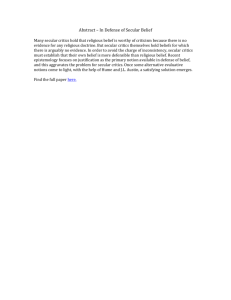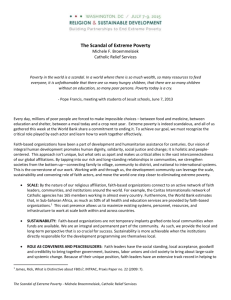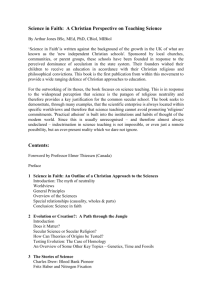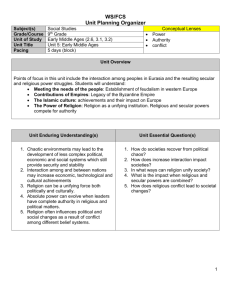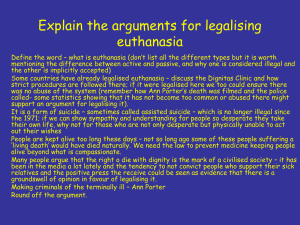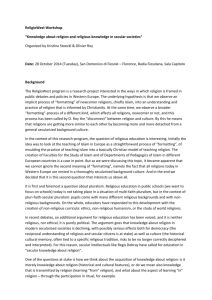where`s the religion: distinquishing faith-based
advertisement
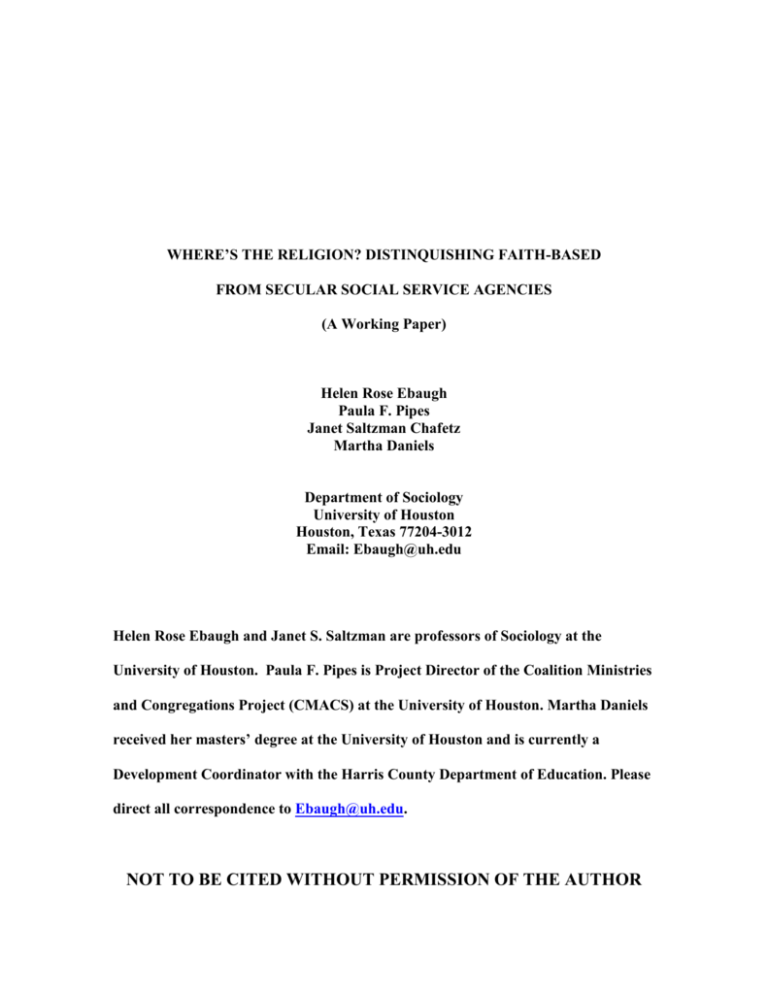
WHERE’S THE RELIGION? DISTINQUISHING FAITH-BASED FROM SECULAR SOCIAL SERVICE AGENCIES (A Working Paper) Helen Rose Ebaugh Paula F. Pipes Janet Saltzman Chafetz Martha Daniels Department of Sociology University of Houston Houston, Texas 77204-3012 Email: Ebaugh@uh.edu Helen Rose Ebaugh and Janet S. Saltzman are professors of Sociology at the University of Houston. Paula F. Pipes is Project Director of the Coalition Ministries and Congregations Project (CMACS) at the University of Houston. Martha Daniels received her masters’ degree at the University of Houston and is currently a Development Coordinator with the Harris County Department of Education. Please direct all correspondence to Ebaugh@uh.edu. NOT TO BE CITED WITHOUT PERMISSION OF THE AUTHOR ABSTRACT The Charitable Choice provision and President Bush’s proposed Faith-Based and Community Initiative have spurred debates regarding government support of faith-based social service programs and their effectiveness. To address the issue of relative effectiveness, the logically prior question of what constitutes a faith-based agency and how they differ from secular providers must be answered. Utilizing data from a mailed survey, this study compares the organizational characteristics of faith-based and secular agencies that provide services to the homeless in Houston, Texas. Results indicate that the two agency types vary significantly across several dimensions including funding sources and preferences, decision-making tools, organizational culture, practices, leadership and staffing characteristics. In addition, survey data and content analysis of mission statements reveal that 80 percent of faith-based agencies use religious imagery in some form of their “public face” to communicate their religiousness. WHERE’S THE RELIGION? DISTINQUISHING FAITH-BASED FROM SECULAR SOCIAL SERVICE AGENCIES Religious institutions in the United States have traditionally delivered social services to disadvantaged groups, and during his campaign George W. Bush pledged to increase the involvement of faith-based organizations in social service provision. Consistent with his policy agenda as governor of Texas, he argued that greater participation by faith-based groups in the social services arena has the potential to improve service delivery. In his first month as President, Bush unveiled the Office of Faith-Based and Community Initiatives and required five federal agencies (recently expanded to include two more) to examine the restrictions on and opportunities for religious groups to receive federal resources for their social service programs. In both the House and Senate bills were introduced to implement the president’s faith-based proposal. The Charitable Choice provision, enacted as Section 104 in the 1996 Personal Responsibility and Work Opportunity Act (known as Welfare Reform), was the predecessor of President Bush’s initiative. Under certain circumstances, this provision allows faith-based groups to compete for government grants without surrendering their religious character. Heated debates have arisen in political, legal, social service, policy and religious circles regarding specific aspects of both the Charitable Choice provision and Bush’s proposed new legislation (DeVita and Wilson 2001). Proponents and critics of increased federal funding for faith-based social services have debated the constitutionality of such funding in light of the First Amendment, as well as the potentially negative consequences of such legislation for religious life in the United States. Despite the fact that many national religious organizations, such as Catholic Charities, Lutheran Social Services and the Salvation Army, as well as many smaller, local coalitions have long received government funds for specific programs (Monsma 1996), Bush’s specific faith-based initiative has created unprecedented discussion and argument both in Washington and across the nation. At the heart of the debate is the fundamental question of what constitutes a faithbased group and how such groups differ from secular providers in their delivery of social services. Compared with secular agencies, how do faith-based organizations structure their social service delivery programs in terms of goals, funding, programs, staffing and organizational culture? Do they display organizational characteristics that differentiate them from secular providers? In what ways are they similar to one another? The proponents of expanding faith-based social service delivery argue that religiously based groups provide more effective social services than secular agencies because their religious character motivates a supportive and caring attitude on the part of staff and volunteers that is transmitted through relationally-based programs aimed at transforming lives (Sherman 1995; White House 200l). If this proves to be the case, there is still the question of exactly which dimensions of faith-based organizations account for their effectiveness? Opponents challenge such assertions and note the lack of empirical evidence to demonstrate that social service provision by faith-based groups is more effective than that delivered by secular groups (Goodstein 2001). Any attempt to empirically examine the relative effectiveness in service delivery of faith-based and secular agencies must first be able to clearly distinguish the two types. While there are a number of sources that discuss differences between the two, to date there has been no empirical work that directly compares them, thereby addressing the question of just what are the defining characteristics of faith based social service delivery agencies that distinguish them from secular agencies. In this paper we present data gathered from agencies that provide services to the homeless in Houston, Texas, that allow us to make such a distinction.i All of the agencies belong to the Coalition for the Homeless of Houston/Harris County, Inc. Thirty two of the agencies that responded to a survey self-identified as faith-based and 53 as secular. In addition to the self identification survey question, we collected mission statements from 58 of the organizations that responded to the survey. The analysis compares key organizational characteristics of the two groups in an attempt to determine whether they differ in their organizational goals, funding sources, programmatic priorities, agency culture and manner of providing social services. Unfortunately, no measure of service delivery effectiveness is available. However, by specifying empirically the variables that distinguish faith-based from secular agencies, the logical first step in addressing the fundamental policy-relevant issue of effectiveness, our work provides the foundation for future research. LITERATURE REVIEW While organizational theory has been used to understand the structure and processes of religious organizations (e.g. Chaves 1997; Becker 1999; Wuthnow 1988; Schoenherr and Young 1993), religious organizations as uniquely religious or faith-based entities have garnered little attention from scholars in the field of organizational study. Likewise, religious researchers have simply assumed that we all know when an organization has a religious character. In the case of congregations, denominations, seminaries, church councils and national ecclesiastical bodies, the assumption of their “religiousness” is rather self-evident. However, when it comes to social service agencies, local civic groups and other voluntary associations devoted to various causes, knowing the name of the organization, its purpose or its public persona may be insufficient to identify it as faith-based. In fact, Joblove (1980) pointed out that legislatures and courts have shed little light on what identifies a group as religious and that “neither a federal income tax statute nor a Treasury regulation has ever defined or explained the term ‘religious,’” a lack still evident more than twenty years later. Unruh’s (200l) study of 76 churches in the greater Philadelphia area focused upon the religious elements of their faith-based social service programs. She conceptualized two basic dimensions of religiosity in these programs: l) environmental elements that include affiliation with a church or denomination, display of religious objects/images, as well as religious literature in the space where the program meets, selection of board members and/or staff based on their religious beliefs and a mission statement that has explicitly religious references; and 2) active religious elements, that is, those that involve direct communication of a religious message to clients or client involvement in specifically religious activities. Unruh proposed the above conceptual scheme based on her work in Christian churches, leaving unanswered the question of whether or to what extent the characteristics she delineates as “religious” might also be found in secular social service agencies. The working group on Human Needs and Faith-Based and Community Initiatives, coordinated by Search for Common Ground, produced a report (2002) that includes a typology of faith characteristics of social service and educational organizations. The typology is conceptualized as a continuum of religiosity ranging from faith-saturated to secular organizations, with faith-centered, faith-related, faith background and faithsecular partnership as degrees between the two extremes. The characteristics of religiosity that are used to place an organization on the continuum are: mission statement; founding for a religious purpose; religiousness of controlling board, senior management and staff; affiliation with external religious agencies; financial support from religious sources; problematic nature of being a 501(c ) 3 organization; religious content of program; connection between religious content and outcomes; and religious environment (e.g. name, building, religious symbols). The Working Group developed the typology based on their experiences with faith-based social agencies and with the expectation that the scheme might provide the basis for empirical research on these agencies. Smith and Sosin (2001), in their attempt to describe the varieties of faith-related agencies, also delineate three general characteristics of such agencies: l) dependency on religious entities for resources; 2) affiliation with and control by a denomination or other religious groups; and 3) religious culture that creates a niche or space for agencies to pursue their religious values. The degree to which an agency is linked to faith is then conceptualized as the extent of “coupling” of the agency to resources, authorities, and cultures that represent relevant faiths. While Jeavons (1998) does not explicitly define a religious organization, his delineation of seven characteristics of such organizations is helpful in beginning to differentiate faith-based organizations from those that are clearly secular in nature and in their functioning. These seven specific traits are: l) Religious groups often self-identify as religious organizations and display this identity in various ways, including choice of name and mission statement. 2) Participants (i.e. paid staff, volunteers, funders, clients) in religious groups tend to be religiously committed individuals, either because of organizational requirements or because the culture of the organization appeals to those who share religious ideals. 3) Material resources, such as money, in-kind donations and buildings, are provided to religious organizations primarily by religious people or organizations. 4) Organizational goals, products and services provided by religious groups are usually of a religious nature, and are performed on the basis of religious values or with “spiritual technologies,” by which Jeavons means the use of worship, prayer, Scripture or spiritual values. He also argues that an organization’s religious culture and “core values” are expressed in its rituals and routines, such as prayer and devotions with the staff. 5) Religious organizations rely on religious values, beliefs, activities or experiences in information processing and decision making. 6) The development, distribution and use of power within religious organizations derive from religious sources and are frequently expressed by the requirement that leadership be invested in a member of the clergy, that a theological education be required of the leadership and that leaders be active in the life of some congregation. 7) Religious organizations tend to interact predominantly with other religious organizations, including denominations, congregations, ecumenical forums and special interest groups with religious goals. Rather than arguing for a dichotomous classification that separates religious from secular organizations, Jeavons posits that the above characteristics offer key issues that point to the relative degree of religiosity of a particular organization along a continuum ranging from clearly religious to completely secular. Stated otherwise, Jeavons’ seven characteristics constitute an ideal type of religious organization and, by implication, an ideal typical description of secular organizations as lacking all seven of these characteristics. In summary, a number of scholars (Unruh 200l; Smith and Sosin 2001; Search for Common Ground 2002; Jeavons 1998) have posited characteristics of faith-based organizations and have suggested that such organizations vary in their degree of religiosity and instititutional ties to denominations and churches. In this paper we present empirical data from a survey administered to faith-based and secular agencies that provide services to the homeless to ascertain whether and in what ways the suggested characteristics, in fact, differentiate the two types of agencies. METHODOLOGY In November-December, 2001 we sent a survey to executive directors in 170 of the 286 agencies in Houston, Texas, listed in the 2001 Homeless Services Directory, a resource directory of homeless agencies compiled by the Coalition for the Homeless of Houston/Harris County, Inc. Government agencies and community development corporations were excluded (N=116) in an attempt to focus on agencies that provide direct services to homeless clients. The Director of the Homeless Services Coordinating Council, the coordinating arm of the Coalition and a collaborator in the current research, was aware from prior interactions with agency personnel that some are faith-based while others are secular. Given the facts that all 170 agencies are located in Houston/Harris county, that each serves the homeless, and that many, both religious and secular, have received government funding through HUD (Housing and Urban Development) grants, we recognized the opportunity to compare organizational characteristics of faith-based and secular agencies that are otherwise similar to one another. Aware of the fact that differences in types of programs may affect organizational characteristics, we interviewed expert informants from the Coalition who assured us that there is no difference in the range and types of social services offered by the two types of agencies, or in their client base and programs. The major research question was the following: Do faith-based organizations differ from their secular counterparts in organizational structure, statement of mission, sources of funding, leadership, everyday practices and overall organizational culture? In addition, we added a number of general organizational questions related to date of founding, numbers of paid and volunteer staff and attitudes toward government funding. Eighty-nine of the 170 agencies responded to the survey, a 52% response rate. Of these 89 agencies, 53 identified themselves on the survey as “secular,” 32 as “religious” and four failed to answer that question. In the analysis that follows, we compare characteristics of the two types of organizations on the basis of their answers to this selfidentity question. Based on characteristics posited in the literature as unique to religious organizations (Unruh 2001; Finding Common Ground 2002; Smith and Sosin 2001; Jeavons 1998), Likert scale items were designed to address the components of each of four major dimensions: decision making, resource preference, organizational culture, and organizational practices (See Appendix I for scale items). The survey utilizes 13 items to measure the degree to which respondents rely on a range of both religious and secular decision-making tools. The resource preferences scale includes 10 items that address respondents’ attitudes towards the use of religious and secular sources for meeting material needs, as well as their attitudes towards using religion as a “cultural resource” to garner needed resources. The culture scale includes 5 items that ask respondents to assess workplace attitudes towards the use of religiously oriented behavior in interactions with clients. The organizational practices scale uses 23 items to measure a full range of religiously oriented activities, including items that assess staff and client-centered religious practices. Client-centered activities addressed in the scale assume that some organizations may engage in practices that more aggressively promote religion than others. For example, the scale includes a question about “mandatory religious services” as well as one about “prayer initiated by clients.” The scale also addresses client services which proponents of the faith-based initiative have positively linked to faith-based programs. These items include questions about client eligibility requirements and the relational component of agency programs. For each scale, factor analysis was used to identify the components of each dimension and to reduce the scale items to a single variable. Items were recoded so that higher factor scores indicate greater “religiosity.” All four scales yielded a reliability score of .84 or higher. Finally, ANOVA was used to test if mean factor scores indicate a statistically significant difference between self-identified faith-based and secular agencies on each of the components. Self-identity was determined on the basis of responses to a question that asked whether the agency is faith-based, secular or was once faith-based and is now secular. We also collected mission statements from 58 of the agencies (almost two thirds of those who answered the survey), 37 of which identified as secular, 18 as religious, and three which did not answer the self-identity question. These statements enable us to analyze the extent to which the organization’s explicit statement of mission reflects a religious character. Staffing and funding characteristics were ascertained by a series of questions that asked number of staff in various organizational positions as well as percentages of funding and in-kind donations from non-religious foundations and businesses, government, and congregations and religiously oriented organizations. FINDINGS Self-identity and its public expression How does one know a faith-based social service agency when one sees it? Is it in the name? Its’ mission statement? Its’ self-definition? This question is somewhat more difficult to answer than it may seem at first blush. On the questionnaire nearly two-thirds (60%) self-identified as currently secular, including 50% who have always been secular and 10% who were religious at some earlier time in their history, and over one third (36%) called themselves religious (the remaining 4% gave no answer). Are these identities evident from their names? We coded organizational names into one of three categories. Religious names might include a particular faith (e.g., Associated Catholic Charities) and/or a religious word such as “ministries” or “interfaith.” Ambiguous titles are those that include proper names or phrases that could reflect a Biblical or other religious origin but might not necessarily do so, for example, “Bridge Over Troubled Waters,” “Ezekiel,” “Martha,” “Ruth,” “San Jose,” etc. Threefifths (61%) of organizational names are secular, 17% are ambiguous and 22% explicitly religious. Clearly, many organizations that define themselves as faith-based cannot be unambiguously identified as such simply from their name, given that about 15% more self-identify in this manner than make the point explicitly in their title. This ambiguity is more obvious when we directly examine the relationship between self-identification and organizational names. Self-identified secular organizations are for the most part easily identifiable as such by secular names: 87% have names with no possible religious connotation. Nonetheless, 4% have religious names and 9% have ambiguous ones. Self-identified religious groups are far less identifiable by name alone. Only a slim majority (53%) have explicitly religious names and another 25% have ambiguous ones, leaving nearly a quarter (22%) with secular titles. Complicating matters more, among organizations with religious names, 11% identify as secular, among those with secular names 13% identify as religious, and among those with ambiguous names, over one-third (38%) identify as secular and 62% as religious. The breakdown of the sub-sample that provided mission statements (N=58) is almost identical to the total sample in their responses to the self-identification question: 63% claim currently to be secular, 32% religious, and 5% failed to answer. Content analysis of these mission statements was conducted by examining each to see if, excluding the organization’s name, it: 1) mentions “god” or “lord”; 2) mentions Jesus or Christ; 3) mentions the Bible or gospels; 4) places service delivery in a religious context or defines it as a religious calling; 5) mentions, as a service provided to clients, meeting spiritual needs or spiritual development; 6) includes a generalized mention of faith, church(es), Christianity, or other religious terms. Self-identified secular organizations can be clearly identified by their mission statements; none includes any words or phrases that fit any of the six content analysis categories. However, among the 18 self-identified religious organizations for which we have mission statements, four (22%) fail to communicate their religious orientation in any way in their statement of purpose, although two of the four claim on the questionnaire that their mission statement reflects their religious orientation. With the exception of reference to the Bible/gospels, the six kinds of words/phrases that we examined are about equally represented—five to seven times each for the self-identified religious organizations whose mission statements include anything of a religious nature. The one exception was found only once. Organizations that include any religious terminology generally include language representing from one to three of the content analysis categories (mean=2.3). A few examples follow, with code numbers (as presented above) in parentheses next to the relevant word or phrase: Our mission, as a coalition of churches (6) responding to God’s (1) word, is to serve others (4), to provide assistance to those in crisis, and to improve their quality of life with the goal of moving them to self-sufficiency. The _______is a Christ-centered (2) community dedicated to meeting the needs of homeless men, women and their children. Positive life changes are encouraged through structured programs which focus on spiritual growth (5), education, employment, life management and recovery from substance abuse. The_______ is a Christ-centered (2) coalition of churches (6) seeking to carry out God’s (1) commandments to love and provide for those in need of our community (4). We seek to improve the physical, emotional and spiritual (5) support necessary to achieve self-sufficiency and independence. These mission statements may be contrasted to an example of one, also emanating from a self-defined religious organization with an explicitly religious name, which is nonetheless completely secular: The __________’s mission is to shelter, serve and teach homeless families with children to learn self-sufficiency, achieve independence and end the homeless cycle in their lives. Yet another way by which social service organizations can communicate a religious orientation is through the use of religious symbolism in their logo. Among selfidentified religious organizations, nearly 70% (22 out of 32) claim on the questionnaire that their logo contains religious symbolism. Logos, along with organizational names and mission statements present the “public face” of organizations. Of the 18 selfidentified religious organizations for which we also have mission statements, over half (10) convey a consistent public face by being named in a religious, or at least religiously ambiguous manner, having a logo that incorporates religious symbolism and a mission statement that employs as least some religious phraseology. Among the 32 self-identified religious organizations in the full sample, 84% (27) present at least one of these three types of religious “faces” to the public (and the remaining 5 cases lack complete data). It would appear that secular and religious social service organizations can be distinguished on the basis of their public presentation of self with, perhaps, only a few errors, but more than one type of indicator is required to do so with confidence. In discussing the reluctance of some religious organizations to express their religious character in their mission statements, logos or name, one expert informant commented that, in her experience, some faith-based agencies are fearful that a religious identity might jeopardize their opportunities for governmental funding. Organizational staffing and funding There is some evidence that faith-based organizations differ from secular agencies in their heavy reliance on volunteer staffing and their lack of government funding (Chaves 2002; Twombley 2002; Printz 1998; Cnaan 1997; Hodgkinson, et.al 1993). We set out to test these assertions by asking specific questions in the survey regarding both issues. In regard to the use of paid vs. volunteer staffing within agencies, the following patterns emerge.2 (Table l about here) In terms of total staff, faith-based organizations average 81.3 compared to 75.7 for secular agencies. Faith-based agencies utilize volunteers to meet their workforce needs more than secular agencies. Volunteers outnumber paid staff by more than 2:1 in faithbased agencies, while the ratio of volunteers to paid staff in secular agencies is a little less than one volunteer for every paid employee (.89:l). At the level of executives and top level managers, although secular agencies have more of both volunteer and paid executives and managers than religious agencies, there is little difference between them in their relative reliance on one type. Both tend to use paid staff extensively and each has about a 2.5:1 ratio of paid to volunteer executives and managers. Supervisors of specific programs differ somewhat between the two types of agencies, with secular agencies using only paid supervisory staff compared to faith-based agencies where the ratio is somewhat over 3:1 paid to volunteer workers. Both agency types average about the same number of supervisory personnel. At the level of professionals (case workers, grant writers, social workers, accountants, intake workers), while secular agencies use more of them, religious and secular agencies are virtually indistinguishable in terms of their reliance on one type; for both, the ratio of paid professionals to volunteers is about l.6:l. It is in the use of clerical and miscellaneous other staff that we see the greatest differences between faith-based and secular agencies; religious agencies average more of both types of staff compared to secular organizations. More importantly, the ratio of clerical staff in religious organizations is about 3 volunteers per paid employee, nearly the reverse of the 2.1:1 ratio of employed to volunteer clerical workers in secular agencies. Likewise, while the overwhelming majority of miscellaneous staff in both types of organizations are volunteers, in the case of religious agencies almost all are volunteers (a ratio of about 15:l), while the secular agencies have about a 3:l ratio of volunteers to paid employees. Again, religious agencies average more miscellaneous staff in general than secular ones. Finally, secular organizations have about equal numbers of paid and volunteer laborers (e.g. drivers, stockers, maintenance employees) while a majority of those performing such tasks at religious agencies are volunteers. Overall, the general pattern among these agencies serving the homeless is that secular and faith-based agencies differ little in the use of paid versus volunteer staff at the higher levels of executives and administrators and professionals; however, faith-based agencies tend to use volunteers more often than the secular agencies as program supervisors, in clerical and miscellaneous staff positions, and as laborers. Government funding has been at the heart of the recent debates regarding the Faith-Based and Community Initiative. Are differences in personnel status carried over to funding sources? The Charitable Choice provision in the Welfare Reform Act allows faith-based agencies to compete with secular ones for public funds. One of the functions of the Coalition for the Homeless in Houston/Harris County is to coordinate and consolidate grant proposals to HUD from local agencies that deal with the homeless. Since 1994 when the coalition began its coordination work, 71 agencies, 28 of which are faith-based, have received $100 million in HUD funding. To what extent do the agencies in our study use government monies for their social service programs and where do they obtain the remainder of their funding? What differences in funding sources exist between faith-based and secular agencies serving the same population of homeless in Houston/Harris county? (Table 2 about here) The most striking finding in Table 2 is that almost half of the faith-based agencies (47%) receive no government funding compared to half (51%) of secular agencies that receive 50% or more of their funds from government sources. Conversely, only about l in 5 (19.6%) secular agencies receive no government funds and only 16% of faith-based organizations receive half or more of their income from the government. These findings corroborate those found by Twombly (2002) in his analysis of 2,000 large, religious and secular human service organizations, based on data from the 1998 Statistics of Income sample, produced by the Internal Revenue Service. Likewise, Monsma (2002) found, in his recent study of faith-based welfare-to-work programs, that faith-based groups are less dependent on government funds than secular organizations that offer the same services. Where do faith-based agencies obtain funding if not from government grants? One possible source is from non-religious foundations and businesses, but the data in Table 2 show that it is primarily secular agencies that receive a substantial proportion of their revenues from this source. Where about 57% of secular agencies receive over a quarter, and 30% over half their money from secular organizations, the comparable figures for faith-based agencies are 28% and 13%. It is evident that most faith-based agencies are getting some money from secular organizations, but usually not more than one quarter of their budget. In large measure, faith-based agencies are supported by religious congregations. Twenty-eight percent of the faith-based agencies receive half or more of their funding from congregations compared with 2% for secular agencies. At the other extreme, 62% of secular agencies receive no funds from congregations compared to only about l in 6 for faith-based. In short, faith-based agencies rely heavily on religious sources for funds while secular agencies acquire most of their financial support from secular sources. (Table 3 about here) In addition to relying on different sources for the majority of their financial resources, secular and faith-based agencies tend to garner in-kind donations from different sources. As Table 3 shows, neither type of organization accesses government sources for in-kind donations to more than a minor extent; approximately three-quarters of each type receive no in-kind donations at all from the government. However, faithbased and secular agencies do differ in their reliance on the other two potential sources of in-kind donations. Religious organizations rely substantially on congregations that provide 47% of them with a quarter or more of their in-kind donations. In fact, almost a quarter of the faith-based agencies receive half or more of in-kind donations from congregations. In contrast, nearly one half of secular agencies receive no in-kind donations from congregations, and only 10% rely on them for 25% or more of their inkind donations. Conversely, nearly half (45%) of the secular agencies receive half or more of their donations from secular organizations, compared to only 6% of faith-based agencies. In addition to asking questions about actual funding sources, we also inquired about the preferences of agencies regarding such sources and their use of religious imagery in donor appeals. Nearly three-quarters (72%) of the faith-based agencies prefer funding that does not compromise their religious character; 56% prefer support from religious organizations rather than from the government, while only 16% prefer government support. However, 66% of faith-based organizations (the same as secular agencies) indicate that they do solicit support from business and other non-religious sources. About three-quarters (72%) of the faith-based agencies say they use religious ideals to appeal to the community for funding support, and 75% of this group indicate that the support of religious leaders is important in soliciting community support for their agency. Only trivial percentages of secular agencies agree with any of the above items except the last. Nearly a third (29%) agree that the support of religious leaders is important in soliciting community support. We conducted a factor analysis on the 10 survey items related to resource preferences and the role of religion in donor appeals. Two factors were identified, one related to the use of religious resources and the other to the use of secular resources. As shown in Panel A of Table 4, a comparison of the mean factor scores for faith-based and secular agencies demonstrates that secular agencies are significantly less likely to pursue religiously based resources or to use religious imagery in their appeals to donors (p<.00l). However, there is no statistically significant difference between faith-based and secular agency preferences regarding the use of secular resources. Clearly, on average, social service agencies that define themselves as faith-based differ substantially from those who consider themselves secular in terms of their resource preferences and their use of religious imagery in funding solicitations. However, as the data reported in this section demonstrate, faith-based and secular social service agencies do not constitute mutually exclusive types. Some secular agencies acquire significant resources from religious groups, and faith-based agencies rely on government funding and secular organizations in non-trivial ways. Religious Policies, Practices and Organizational Culture Are faith-based agencies identifiable in their expression of religiosity in organizational policies, practices and culture? Do they differ from secular agencies in the manner in which they choose leaders, draw clients, deliver social services and attract staff? We asked six questions regarding leadership in the agency: whether the organization has a policy that some board members must be clergy or have a theological education, degree to which religious leadership is important to fulfilling the organizational mission and guiding organizational strategies, whether personnel policies model religious values, the degree to which business leaders are chosen as board members, and whether board members routinely approve recommendations of executive management staff rather than exercise independent leadership.3 In terms of policies requiring that some board members be clergy or have a theological education, 91% of secular agencies do not have such a policy compared with 62.5% of faith-based ones. On the other hand, while 70% of secular agencies target business leaders as board members, almost 50% of faith-based agencies also solicit members of the business community as members of their board. Regarding the fulfillment of their mission, faith-based agencies claim that religious leadership is important (47%) while only ll% of secular agencies make such a claim. In general, faith-based agencies rely heavily upon religious leadership on their boards of directors (a practice not common in secular agencies) while both types of agencies depend upon business leaders and executive staff to provide leadership on the board. (Table 4 about here) We presented 13 types of informational input that can be used in programmatic decision making and asked respondents how central each source is in the decision making process within his/her agency. These items include: religious beliefs, sacred texts, religious authorities, divine guidance of the Spirit, God’s providence or intervention, prayer, humanitarian values, public awareness, non-religious advisors and professional reports, material and reports from religious sources and client needs based on observation and interaction with them. Two factors emerged: religious sources and secular input. Panel B of Table 4 shows that religious agencies rely heavily on the former sources, unlike secular agencies (p<.00l). However, there is no statistically significant difference in the degree to which both types of agencies use secular sources of input. We now turn now to the question of whether, according to the agency Executive Directors, clients and staff choose a faith-based rather than secular agency because of its religious character. In terms of agency personnel, religious orientation is a major factor in hiring paid staff. Hiring practices are especially salient in light of the heated debate in the U.S. Congress regarding the constitutionality of discriminatory hiring practices on the part of faith-based organizations that apply for government funds. About one tenth (12 %) of the faith-based agencies say that, in hiring, they prefer candidates from a particular religion; 34% favor candidates from some religion rather than none, and 47% disregard religion in their hiring practices. Nearly half, therefore, take religious affiliation into account when hiring. Half of the faith-based agencies say that a shared religious doctrine among staff members is important to fulfilling their mission and 72% are convinced that having religious staff members promotes the mission of the agency. The fact that these agencies share a strong conviction that having religiously oriented staff is central to the fulfillment of their mission underscores the basic discriminatory hiring dilemma that constitutes the major hurdle facing the U.S. Senate in supporting President Bush’s desire to increase funding for faith-based organizations. Program directors perceive that their staff is attracted by their religious nature. When asked about employee satisfaction and reasons that employees enjoy work, 90% of the directors replied that their employees, both paid and volunteer, like their work because it is religiously based; 75% responded that their paid employees like the religious orientation of the agency and choose to work there because the agency is faith-based. In fact, approximately 70% of the faith-based agencies recruit volunteers from congregations and, interestingly, about 20% of secular agencies turn to congregations for recruitment as well. In contrast to staff member preferences, only one-quarter (28%) of the directors of faith-based agencies claim that clients come to them because the agency is religiously oriented while the remaining 72% respond that religious orientation is unimportant in attracting clients. Regarding practices within the agencies, we asked 23 questions related to specific activities, including items such as: distributing religious material to clients, one-on-one prayer with clients, prayer with staff and volunteers, asking clients about their religious beliefs, mandatory religious services for clients, inviting clients to religious services, prayer at board meetings, testimonies praising God, displaying religious items in public areas, and prayer before meals. We also included activity items related to the flexibility and relational components of their social service programs in light of proponents’ arguments that these characteristics are directly related to faith-based organizations’ presumably superior effectiveness. We submitted these items to factor analysis in which two factors were identified, one related to religiosity and the other to client services.4 As evident in Panel C of Table 4, faith-based and secular agencies differ significantly on the religiosity factor (p<.00l). However, on the client services factor there was no statistically significant difference between the two types of agencies. Therefore, what differentiates the activities of faith-based from those of secular agencies is their use of religious practices oriented towards both clients and staff. What does not differentiate faith-based from secular agencies is their broader social services orientation. Both use strict eligibility criteria, refer to common values in their interactions with clients and offer mentoring programs based on personal relationships with clients. In addition to including items on religious practices on the survey, we also inquired about the overall organizational culture in regard to some of these practices by asking the respondent, usually the executive director, whether most employees would support or discourage four religiously oriented behaviors: praying with a client, promoting a particular religious viewpoint to a client, speaking about spiritual matters to clients, and discussing behavioral issues using religious principles. The four items resulted in one factor, on which there is a statistically significant difference (p<.001) between faith-based and secular agencies (Panel D, Table 4). As might be expected, secular agencies disapprove strongly while faith-based agencies approve of these religiously oriented practices. However, examination of responses to individual items reveals several contradictory findings regarding the attitudes of a minority of secular agencies: 26% agree or strongly agree with the practice of praying with clients and 42% approve of speaking about spiritual matters with clients. Attitudes toward the use of religious practices within secular agencies, therefore, indicate that religiously oriented interactions with clients are not totally frowned upon. DISCUSSION AND CONCLUSIONS Guided by studies that suggest organizational characteristics that differentiate faith-based from secular social service agencies (Jeavons 1998; Unruh 200l; Search for Common Ground 2002; Smith and Sosin 200l; Ebaugh and Pipes 200l; Pipes 200l; Pipes and Ebaugh 2002), we set out to examine empirically how the two types of agencies differ in their identity, staffing, funding sources, culture and organizational practices. Based on survey data and mission statements from faith-based and secular agencies that provide services to the homeless in Houston, we have reported both differences and similarities between the two types of organizations. In this concluding section, we summarize our main findings. Self-Identity We used a self-identity question as our measure of whether to define a given organization as secular or faith-based. We found that while self-identified secular organizations almost always have secular names and always have secular mission statements, their religious counterparts are more inconsistent. However, about threequarters have a religious or at least religiously ambiguous name, use at least some religious phraseology in their mission statements and report religious symbolism in their logo. Over 80% use at least one of these components of their “public face” to communicate their religiousness. We conclude, therefore, that in most cases one can identify a faith-based organization by at least one component of its public presentation of self. Participants and Leadership: When we compared paid and volunteer staffing, we found that, in toto, faithbased agencies appear to rely more on volunteers. On average, relative to secular agencies, faith-based agencies probably utilize volunteers at a higher rate as program supervisors and especially in clerical, miscellaneous staff and laborer positions, while not differing in the staffing of executive, managerial and professional positions. Faith-based agencies report that religious staff and leadership are important to fulfilling their mission. Nearly half of all faith-based agencies take religious affiliation into account when making hiring decisions, and nearly three quarters recruit staff from congregations. Most also perceive that both their paid and volunteer work force choose to work at the agency because it is faith-based. It would appear that, while many faith-based organizations do not have a formal policy requiring workers to adhere to a faith, most paid staff and the numerous volunteers at such organizations are religiously committed people who are motivated to work at a faith-based agency for religious reasons. However, from the perspective of executive directors in both types of agencies, clients are not motivated to select a given agency for religious reasons. Material Resources: While secular agencies receive significant funding from government and other secular sources, faith-based agencies receive little such support. Conversely, faith-based agencies, unlike secular ones, receive a significant amount of their support from congregations and other religious organizations. Furthermore, faith-based agencies express a clear preference for religious sources of funding. Products and Organizational Culture: In our sample of agencies that deliver social services to the homeless, faith-based and secular agencies do not differ in the range of direct services delivered to clients. President Bush and proponents of his Faith-based and Community Initiative frequently argue that faith-based social service agencies are more effective because they provide flexible services involving relational programs. However, we found that the two types of agencies do not differ on a factor that reflects their client orientation, that is, programs that seek to establish relationships with clients. They do differ significantly in the fact that faith-based agencies deliver a variety of religious services as part and parcel of their social service delivery. In addition, the factor we call “organizational culture” significantly differentiates religious from secular agencies, with the former supporting a culture thoroughly imbued with religious values in terms of staff interactions with clients. Information processing and decision-making: Religious and secular agencies differ significantly on the centrality of religious leadership to organizational functioning, but not in their reliance on business leaders and executive management in board operations. In other words, both types of agencies rely on secular expertise, but faith-based ones rely as well on spiritual expertise to reach decisions. Asked about sources of input for decisions, two factors once again emerged: faith-related sources, on which the two types of agencies differ significantly, and secular inputs on which there is no difference. In summary, secular and faith-based organizations delivering the same range of social services to the same population in the same metropolitan area differ consistently and significantly on a number of organizational characteristics. While not totally absent from secular agencies, religion is what makes faith-based agencies religious. Where’s the religion? Everywhere. Religion infuses agency self-presentation, personnel, resources, decision-making processes, and interactions with clients and among staff in faith-based agencies. Importantly, secular and faith-based agencies appear to equally value and utilize secular expertise and input in decision making, employ paid staff at the upper managerial and professional levels, and offer flexible and relationally-based programs. Therefore, as this study demonstrates, religion constitutes an “add-on” that differentiates the two types of agencies. The Bush administration’s Faith-Based and Community Initiative has stirred debates regarding the relative effectiveness of faith-based versus secular social service delivery, and the role of government in their support. The issues raised in these debates cannot be addressed empirically without a clear method of distinguishing faith-based from secular social service agencies. While several models have proposed characteristics related to faith-based organizations, ours is one of the first studies designed to examine how they do and do not differ empirically from secular ones. Our findings demonstrate that these measures can serve as empirical indicators to separate secular from faith-based social service agencies. Furthermore, because we have identified several dimensions that comprise the religious character of faith-based social services, when researchers attempt to explore the effectiveness of such agencies they may find that some specific dimensions are more highly related to given outcomes than others. Finally, some opponents of government funding to faith-based organizations express concerns that such funding might alter their character. To assess this would require delineating relevant dimensions, such as those examined in this paper. Endnotes We use the term “faith-based” agencies rather than “faith-related,” as suggested by Smith and Sosin (2001), for several reasons. First, the term “faith-based” relates more directly to current policy debates. Secondly, we felt that the term “faith-based” would be more familiar to agencies when asked in the survey to self-identify as faith-based or secular. Likewise, the term “faith-based organization” is more appropriate for our study than “faith-based program,” as Unruh (200l) prefers, because we did not ask respondents about each program in their agency. 2 Given the small sample size, none of the differences in Table l reached statistical difference. 3 Cronbach’s alpha for these six items (.73) is below the .80 that we established for minimal reliability for the scales. 4 The religiosity factor includes items that address client and staff oriented activities and environmental characteristics. Although these items all loaded onto a single factor, it is possible that there are multiple dimensions to the religiosity scale that might be identified with a larger sample size and/or one including only faith-based organizations. Appendix I Likert Scale Items Decision-Making Tools To what extent do the factors below influence programmatic decisions: Religious beliefs Sacred texts such as the Bible Religious authorities The leading of the Holy Spirit or divine guidance God’s intervention or providence Prayer Humanitarian values Public awareness Non-religious advisors or consultants Academic and professional reports Materials and reports from religious organizations Client needs obtained through observation and interaction Resource Preferences Our organization prefers to receive resources from sources that will not compromise our religious character. Our organization uses religious images and/or texts in its appeal to potential donors. Donors support the organization because of its religious orientation. Our organization has lost potential donors because we are not religious enough. It is possible that our organization has lost support or missed opportunities for funding because it is too religious. Religious leaders are important for maintaining community support for our organization. Our organization serves an important function by bringing a religious perspective to public opinions about issues that impact our clients. Our organization uses religious ideals in our communications to the community. Our organization prefers support from the religious community rather than government support. Our organization solicits support from business and other non-religious organizations. Organizational culture Please indicate how most other employees would view: Volunteer or staff member prays with a client. Volunteer or staff member promotes a particular religious viewpoint to a client. Volunteer or staff member offers encouragement to a client by speaking of spiritual matters. Volunteer or staff member discusses lifestyle or behavioral issues using religious principles. Organizational Practices Please indicate the frequency with which the following practices are performed in your agency. Distribute religious materials to clients. Prayer involving clients one on one. In interactions with clients, refer to common values that may or may not be religiously based. Refer to religious principles in conversations with clients. Refer to religious principles in client workshops. Prayer involving staff members or volunteers. Prayer at organizational functions involving the public. Ask clients about their religious beliefs. Mandatory religious services for clients. Invite clients to attend religious services. Share a devotional time with staff or volunteers. Include prayer at board meetings. Prayer initiated by clients. Testimonies praising or acknowledging God. Display religious images representing a particular faith. Prayer before meals that include clients. Prayer with groups of clients other than before meals. Rely on strict policies to determine clients’ eligibility for services. Offer mentoring or other types of programs that are based on establishing a relationship with the client. Display religious materials in the waiting room and other common workspaces. Meet regularly with a client to discuss issues important to them. REFERENCES Becker, P. E. 1999. Congregations in Conflict: Cultural Models of Local Religious Life. New York: Cambridge University Press. Cnaan, R. A. 1997. Social and community involvement of religious congregations housed in Historic religious properties: Findings from a six-city study.” Philadelphia: University of Pennsylvania School of Social Work, Program for the Study of Organized Religion and Social Work. Chaves, M. 1997. Ordaining Women: Culture and Conflict in Religious Organizations. Cambridge, Massachusetts: Harvard University Press. _________. 2002. “Congregations and social services: What they do, how they do it, and with whom.” Nonprofit and Voluntary Sector Quarterly 30:660-683. De Vita, C.J. and Wilson, S. 2001. “Faith-based initiatives: Sacred deeds and secular Dollars.” Emerging Issues in Philanthropy Seminar Series. Washington, D.C.: The Urban Institute. Ebaugh, H.R. and P. F. Pipes. 200l. “Immigrant congregations as social service Providers: Are they safety nets for welfare reform?” In Religion and Social Policy, edited by Paula Nesbitt. Walnut Creek: AltaMira Press. Goodstein, L. 2001. “Church-based projects lack data on results.” New York Times, April 24. Hodgkinson, V.A., M.S. Weitzman, A.D. Kirsch, S.M. Noga, and H.A. Gorski. 1993. From Belief to Commitment: The Community Service Activities and Finances of Religious Congregations. Washington, D.C.: The Independent Sector. Jeavons, T. H.1998. “Identifying characteristics of ‘religious’organizations: An exploratory proposal.” In Sacred Companies: Organizational Aspects of Religion and Religious Aspects of Organizations. Edited by N.J. Demerath III, et. al. New York: Oxford University Press. Joblove, Leonard. 1980. Special Treatment of Churches under the Internal Revenue Service Code. PONPO Working Paper#21. Yale University. Monsma, Stephen. 1996. When Sacred and Secular Mix: Religious Nonprofit Organizations and Public Money. Lanham, MD. ______________. 2002. Working Faith: How Religious Organizations Provide Welfare to Work Services. Philadelphia, PA: Center for Research on Religion and Urban Civil Society, University of Pennsylvania. Pipes, P.F. 2001. Community Ministries Today: Nine Regionally Dispersed Case Studies. Annie E. Casey Foundation. Pipes, P. F. and H.R. Ebaugh. 2002. “Faith-based coalitions, social services, and government funding.” Sociology of Religion 63:49-68. Printz, T.J. 1998. “Faith-based service providers in the nation’s capital: Can they do more?” Washington, D.C.: The Urban Institute. Charting Civil Society, Center on Nonprofits and Philanthropy Policy Brief No. 2, April. Schoenherr, R. A. and L.A. Young. 1993. Full Pews and Empty Altars: Demographics of the Priest Shortage in United States Catholic Dioceses. Madison, Wisconsin: University of Wisconsin Press. Search for Common Ground. 2002. “Finding Common Ground: 29 Recommendations of the Working Group of Human Needs and Faith-Based and Community Initiatives.” Washington, D.C. Sherman, A.L. 1995. “Cross purposes: Will conservative welfare reform corrupt religious Charities?” Policy Review pp.58-63. Smith, S.R. and M.R. Sosin. 2001. “The varieties of faith-related Agencies.” Public Administrative Review 61:651-669. Twombley, Eric C. 2002. “Religious Versus Secular Human Service Organizations: Implications for Public Policy.” Social Science Quarterly 83: 947-961. Unruh, H.R. 2001. “Religious elements of faith-based social service programs: Types and integrative strategies.” Paper presented at the Society for the Scientific Study of Religion Meetings, Columbus, Ohio. October. White House. 2001. Rallying the armies of compassion [online]. www.whitehouse.gov/news/reports. Wuthnow, R. 1988. The Restructuring of American Religion. Princeton, New Jersey: Princeton University Press. i We use the term “faith-based” agencies rather than “faith-related,” as suggested by Smith and Sosin (2001), for several reasons. First, the term “faith-based” relates more directly to current policy debates. Secondly, we felt that the term “faith-based” would be more familiar to agencies when asked in the survey to self-identify as faith-based or secular. Likewise, the term “faith-based organization” is more appropriate for our study than “faith-based program,” as Unruh (200l) prefers, because we did not ask respondents about each program in their agency. 2 Given the small sample size, none of the differences in Table l reached statistical difference. 3 Cronbach’s alpha for these six items (.73) is below the .80 that we established for minimal reliability for the scales. 4 The religiosity factor includes items that address client and staff oriented activities and environmental characteristics. Although these items all loaded onto a single factor, it is possible that there are multiple dimensions to the religiosity scale that might be identified with a larger sample size and/or one including only faith-based organizations.

